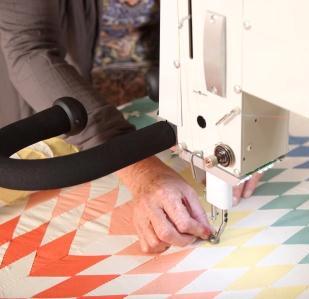Thread breakage
 When you’re hard at work on a quilt, and your thread decides not to cooperate, your blood pressure can increase exponentially. Most thread breakage issues have easy solutions. When thread breaks, it is either at its “stress point” or something is snagging it, causing it to break. The trick to finding the right answer is to use a step-by-step process to eliminate the obvious suspects instead of trying a shotgun approach. We assume you have chosen a quality thread to begin with, since inconsistencies in quality and strength lead to problems all around.
When you’re hard at work on a quilt, and your thread decides not to cooperate, your blood pressure can increase exponentially. Most thread breakage issues have easy solutions. When thread breaks, it is either at its “stress point” or something is snagging it, causing it to break. The trick to finding the right answer is to use a step-by-step process to eliminate the obvious suspects instead of trying a shotgun approach. We assume you have chosen a quality thread to begin with, since inconsistencies in quality and strength lead to problems all around.
Step 1: Try a different cone of thread
Even with the highest quality thread, you can have a bad spool or even a small section on a spool. If you are using the same type of thread for your replacement spool as your spool that is breaking, then your first cone may have a bad section. Pull off several yards and try again, or get a different spool.
However, if your thread continues to break, try a thread that you have had success with in the past. If it sews well, then the solution lies in the thread path, tension, or thread quality. But if it continues to break as well, move on to these additional steps.
Step 2: Re-thread the machine
Don’t get lazy here and just trust your eyes. Take the time to go back to the thread cone, and start completely over. Be sure to “floss” the thread down into the tension disks.
Step 3: Insert a new needle
The eye of a needle can be very sharp, which can shred and cut thread.
Step 4: Loosen the top and bobbin thread tension a lot
Loosen the top tension until the tension disks are almost flopping, and loosen the bobbin case tension until the bobbin case reaches to the floor. See if you can remove most of the tension and simply get the machine to sew, no matter how ugly the stitches are. This step will help eliminate tension settings as the reason for the breakage.
If the thread does not break with this loose setting, then begin by tightening the top tension knob again, one-half turn at a time as you check your stitch quality. Adjust the bobbin tension as well to fine-tune your stitches.
Many times thread breaks simply because the tension settings are too tight for the thread. To start with a loose setting and tightening the tension produces better results than to try working backwards from a too-tight setting.
Step 5: Change the thread path
Thread coming off the cone in a clockwise direction should follow the normal threading procedure in most cases, with the thread wrapping through the 3-hole guide near the tension disks in a counter-clockwise direction (back to front). However, if the thread exits the cone counter-clockwise, try turning the cone over to reverse its feed.
Other threads perform better with a straighter line through the thread path (i.e. King Tut, metallic threads, holographic threads). Instead of wrapping the thread around the 3-hole guide, try weaving it through the guide instead -up into the rear hole, down in the middle hole, up through the third hole and on toward the tension disks. This removes some of the twisting action that can break thread.
Step 6: Examine the thread path for burrs
If you’ve ever broken a needle, you’ve got a burr somewhere. It’s always amazing how one tiny burr can break even the toughest thread. Some burrs or grooves happen just as a matter of wear and use of the machine. Use a magnifying glass and carefully study any surface the top thread rubs against while on its journey into your quilt. Change the parts if you find a burr, or smooth the burr with very fine crocus cloth or emery cloth (400 grit or finer, found in the hardware or automotive store). Here are the common places to look for burrs or wear grooves:
- Pigtail Thread Guides
- Tension Check Spring
- Needle Plate Hole
- Hook Assembly
- Hook Retaining Finger
Threads like invisible thread, metallic thread, and heavy poly ester thread will create wear grooves in the thread guides. Keep spare guides on hand and replace them if necessary. As a temporary fix, loosen the screw holding the guide in place, and rotate the guide 180 degrees so the thread rubs on a different part of the guide.
Your top thread rubs on all sides of the needle hole in the needle plate. If you’ve scarred the plate with a scratch from a needle, your top thread will break. Smooth out the rough spot with the emery cloth, taking care not to polish it so much that you enlarge the hole.
The hook assembly has several locations where the needle could strike it and cause burrs. Check your machine manual appendix section for an appendix titled “Hook Maintenance” for important tips on caring for your hook assembly and retaining finger.
Step 7: We’re here to help. Call Us!
If this short list of self-help strategies does not do the trick, by all means call us. Take advantage of the lifetime customer support you receive from APQS, whether you’re a new owner or have been at it for 20 years. Together we’ll get you back to quilting!
APQS Customer Support Line: 800.426.7233



